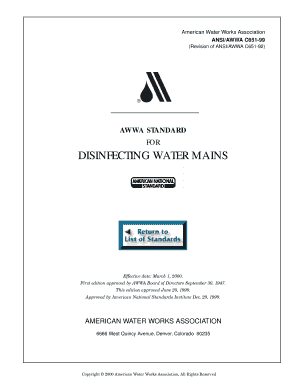AWWA C Disinfecting Water Mains. Current; Document Language: English; Published By: American Water Works Association (AWWA). This standard presents essential procedures for the disinfection of new and repaired potable water mains. All new water mains shall be disinfected before they. FIELD CHLORINATION. • AWWA/ANSI C – Disinfecting Water Mains. • First standard approved Sept. 30, • Latest revision June 1.

| Author: | Balabar Kicage |
| Country: | Gambia |
| Language: | English (Spanish) |
| Genre: | Environment |
| Published (Last): | 3 March 2017 |
| Pages: | 401 |
| PDF File Size: | 15.90 Mb |
| ePub File Size: | 2.70 Mb |
| ISBN: | 148-2-94868-191-9 |
| Downloads: | 21483 |
| Price: | Free* [*Free Regsitration Required] |
| Uploader: | Dojar |
These steps also apply to the planned maintenance of watermain Appurtenances and fittings refer to section 1.
Examples of typical steps for Category 1, 2 and for special cases are attached as Appendices C, D and E respectively. Appendix B Tools to help determine the category of watermain break – pictures Examples of watermain breaks that are typical of Category 1 are included below for illustrative purposes only: Upon completion of the excavation, the Operator-in-Charge OIC shall conduct a visual inspection to determine the nature of the break.

Additional steps shall be undertaken as appropriate to remove Contaminants from the watermain, such as:. Notification to the local Ministry office is not required for Category 2 watermain breaks unless:.
Flushing watermain cleaning, the requirements of section 3. Longitudinal watermain break with evident Contamination.
If Contamination is evident or suspected, the procedures defined under section 3 for Category 2 watermain breaks shall apply. If, at any time, Contamination is evident or suspected, the break shall be reclassified as Category 2. All samples shall be considered distribution samples, staneard and tested in accordance with O.
Operating authorities may choose to provide notification to, or seek advice from, the local Medical Officer of Health at any time. If the water level in the excavation rises such that the Air gap is not maintained after flow from the break has been discontinued, then the srandard break shall be classified as Category 2.
Watermain disinfection procedure |
For planned swabbing and hydraulic e. Discharges of flushed water are also regulated under Condition 4.
Example 3 When using the slug method of chlorination, with a minimum contact time of 3 hours, the chlorine concentration shall be measured in the slug at the beginning of the disinfection process, as the slug moves through the watermain, and at the point of discharge. If planned maintenance, indicate type of planned maintenance e. The watermain may be returned to normal service defined as having all valves returned to normal operating position prior to receipt of sample results.
This document outlines procedures for disinfecting water mains as part of an addition, modification, replacement, extension, planned maintenance, or zwwa repair in a municipal residential drinking water system.
The flow shall be directed to ensure that the sample represents water that has passed through the location of the repair. If final disinfectant residual is less than 0. Return to normal service is contingent upon the corrective actions and sampling plan being completed to the satisfaction of the local Ministry office in consultation with the local Medical Officer of Health.
Category 1 watermain breaks are not defined as an observation of improper disinfection in accordance with Section of Schedule 16 of O.
Watermain disinfection procedure
The discharged water is deemed to be a Class II spill etandard the purposes of O. Category 2 watermain breaks are not required to be reported to the Spills Action Centre unless an operating authority believes that contaminated water was directed to users. When using the slug method of chlorination, with a minimum contact time of 3 hours, the chlorine concentration shall be measured in the slug at the beginning of the disinfection process, as the slug moves through the watermain, and at the point of discharge.
If there is evident or suspected sewage Contamination of a watermain, in addition to the procedures in sections 3. Examples of watermain breaks that are typical of Category 2 are included below for illustrative purposes only: The requirements in this section also apply to temporary watermains.
AWWA C / AWWA C / AWWA C – Disinfection Of Water Package
For all other types of cleaning e. Pipe and Repair Parts disinfected? Appendix C Category 1 flowchart The following flowchart is an example of the typical steps required for Category 1 watermain breaks Note: The following flowchart depicts the requirements for special case Contamination sewage or chemical as a result of a watermain break.
Flushed water may be discharged from a hydrant, plumbing or Appurtenances. Where there is no discharge point to allow for Flushing, the operating authority shall tap the watermain on the downstream side of the break and discharge from that point. Operating Authorities may choose to provide notification to, or seek advice from, the local Medical Officer of Health at any time.
For relining of existing watermains, the conditions of section 1. This definition does not include recharging the watermain or a requirement to achieve scouring velocity within the watermain.